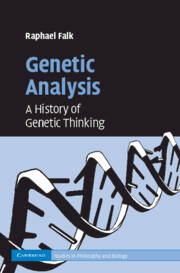Book contents
- Frontmatter
- Contents
- List of figures
- Acknowledgments
- Introduction
- PART I FROM REPRODUCTION AND GENERATION TO HEREDITY
- PART II FAKTOREN IN SEARCH OF MEANING
- 3 From Faktoren to unit characters
- 4 The demise of the unit character
- PART III THE CHROMOSOME THEORY OF INHERITANCE
- PART IV GENES AS THE ATOMS OF HEREDITY
- PART V INCREASING RESOLVING POWER
- PART VI DEDUCING GENES FROM TRAITS, INDUCING TRAITS FROM GENES
- PART VII WHAT IS TRUE FOR E. COLI IS NOT TRUE FOR THE ELEPHANT
- Concluding comments
- Bibliography
- Index
3 - From Faktoren to unit characters
Published online by Cambridge University Press: 07 August 2009
- Frontmatter
- Contents
- List of figures
- Acknowledgments
- Introduction
- PART I FROM REPRODUCTION AND GENERATION TO HEREDITY
- PART II FAKTOREN IN SEARCH OF MEANING
- 3 From Faktoren to unit characters
- 4 The demise of the unit character
- PART III THE CHROMOSOME THEORY OF INHERITANCE
- PART IV GENES AS THE ATOMS OF HEREDITY
- PART V INCREASING RESOLVING POWER
- PART VI DEDUCING GENES FROM TRAITS, INDUCING TRAITS FROM GENES
- PART VII WHAT IS TRUE FOR E. COLI IS NOT TRUE FOR THE ELEPHANT
- Concluding comments
- Bibliography
- Index
Summary
Heredity is, of course, at the heart of any theory of evolution, and more specifically at the heart of the Darwinian hypothesis of evolution by natural selection: it is inherited variability that provides the raw material upon which natural selection can operate. In 1868 Darwin presented a “provisional hypothesis of pangenesis,” in The Variation of Animals and Plants under Domestication. Pangenes, representing all organs, were assembled in the gametes and merged in the zygote to be farmed out to the respective newly formed organs (Darwin, 1868). Although Darwin conceived of “[t]wo distinct elements [that] are included under the term ‘inheritance,’ namely the transmission and the development of characters” (Darwin, 1981 [1871], 279), his hypothesis was essentially a top-down hypothesis of reproduction. As a hypothesis of inheritance it was unacceptable on both theoretical and empirical grounds. Already in 1867, Fleeming Jenkins had shown that in Darwin's blending model of inheritance all variation would be “swamped out” long before it could be established by natural selection (see Hull, 1973, 302–350). Others, like Thomas H. Huxley and, later, Francis Galton, were just as worried about the empirical evidence of the nonheredity of (most of) the intraspecific variation (Falk, 1995, 226).
PANGENES AND FAKTOREN
Contrary to common lore, Mendel's paper was not unknown in the thirty-four years between its publication and its acceptance as significant (see letters to Roberts, in Stern and Sherwood, 1966; Jahn, 1957/58; and Weinstein, 1977).
- Type
- Chapter
- Information
- Genetic AnalysisA History of Genetic Thinking, pp. 44 - 57Publisher: Cambridge University PressPrint publication year: 2009



